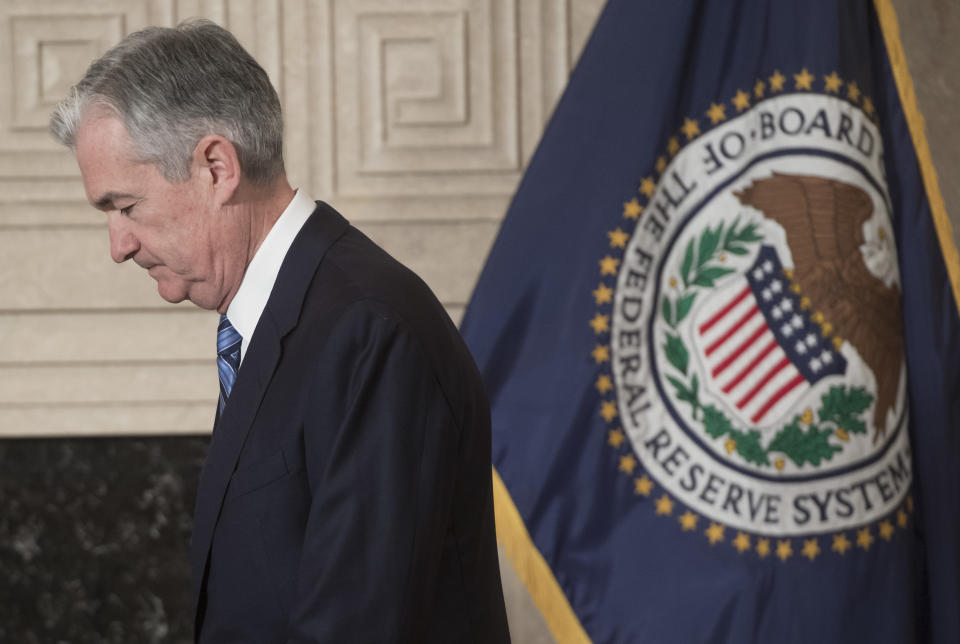HP, Herbalife, initial claims — What you need to know in markets on Thursday
Bonds matter again!
On Wednesday, stocks were higher, then moved way higher, and then sold off hard into the close after Treasury yields hit new highs as investors brace for a more aggressive Federal Reserve.
When markets settled, the Dow fell 167 points, or 0.6%, while the S&P 500 dropped 14 points, or 0.5%, and the tech-heavy Nasdaq lost 16 points, or 0.2%. After the release of the Fed minutes at 2:00 p.m. ET, the Dow had been up more than 200 points.
The 10-year Treasury yield hit 2.95% on Wednesday, the highest since 2013, with the 2-year hitting 2.26% after the minutes from the latest FOMC meeting indicated Fed officials are expecting inflation to rise in the year ahead.
Higher interest rates, you’ll recall, were originally cited as the trigger behind the stock market sell-off earlier this month.
On Thursday, the economics calendar will be calm with the weekly report on initial jobless claims serving as the only notable piece of data due out.
Earnings expected out Tuesday include results from HP Enterprise (HPE), Hewlett Packard (HPQ), Intuit (INTU), Herbalife (HLF), and Wayfair (W).
Investors will also be keeping an eye on shares of Roku (ROKU) on Thursday, as the stock — which has more than doubled since its late-2017 debut — was down about 20% after reporting earnings after the market close.

Minutes reaction
The minutes from the Federal Reserve meeting are about as subtle as it gets when it comes to potential market-moving news.
The report, which details the thinking of Fed officials during a two-day meeting which saw its eventual policy decision announced two weeks ago, is sort of a close reading exercise for investors and economists who often use numbers to back into a text-based narrative story to tell themselves, clients, the media, and so on. The minutes are just text.
And so Wednesday’s reaction from markets was fascinating in that the market’s initial read appears to see the minutes taken as a dovish sign from the Fed, meaning they augured for more conservative interest rate increases from the central bank, until this view flipped aggressively.

In a note Wednesday after the dust cleared, economists at Capital Economics wrote that, “The minutes of the late January FOMC meeting show that officials were firmly on track to raise interest rates again in March, even before the latest incoming data showing stronger wage growth and core inflation or the boost to Federal spending.”
The firm added that, “We have long expected the Fed to hike interest rates four times this year, on the basis that Congress would loosen fiscal policy and core inflation would rebound markedly in 2018. That view is now rapidly gaining traction in the markets and among other economists. Fed officials themselves are still projecting three rate hikes, but were clearly more focused on the upside risks at this meeting.”
In short, a more-aggressive-than-in-recent-years Federal Reserve is now the base. An outright hawkish Fed — which perhaps raises interest rates 5 times this year — also seems to have been put in play by markets.
Other Wall Street economists, however, are not sure that Wednesday’s view of the minutes changing the calculus for the Fed will hold.

“We see upside risks as having risen since the January meeting, but we doubt the committee is ready to shift to four hikes,” writes Michael Gapen, an economist at Barclays. “The effects of the fiscal stimulus are likely to take some time to work through the economy, and participants can afford to be patient and watch how the data evolve. We think the shift to four hikes this year is more likely to come in June, or perhaps September, depending on how quickly the unemployment rate moves lower.”
At JP Morgan, Jesse Edgerton writes that, “If one were to split hairs, one could argue that these statements only imply increased confidence in the need for the three 2018 hikes that were predicted by the median December dot, and do not necessarily imply a greater likelihood of more than three hikes. But we think increased confidence in the need for further hikes will accompany a perceived need for more than three hikes among a growing portion of the committee.”
And so it seems then that we have a clear tension arising between the Fed and the bond market that will need to be sorted out during the months to come. The bond market expects the Fed will raise interest rates four times (at least) in 2018; the Fed seems unlikely to commit to this move until the middle of the year, if at all.
Someone will be wrong.
—
Myles Udland is a writer at Yahoo Finance. Follow him on Twitter @MylesUdland
Read more from Myles here:
One candidate for Amazon’s next headquarters looks like a clear frontrunner
Tax cuts are going to keep being a boon for the shareholder class
Auto sales declined for the first time since the financial crisis in 2017
Foreign investors might be the key to forecasting a U.S. recession
It’s been 17 years since U.S. consumers felt this good about the economy

 Yahoo Finance
Yahoo Finance 
